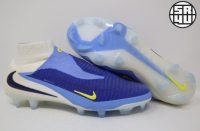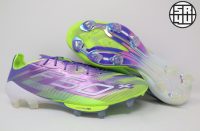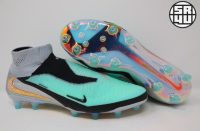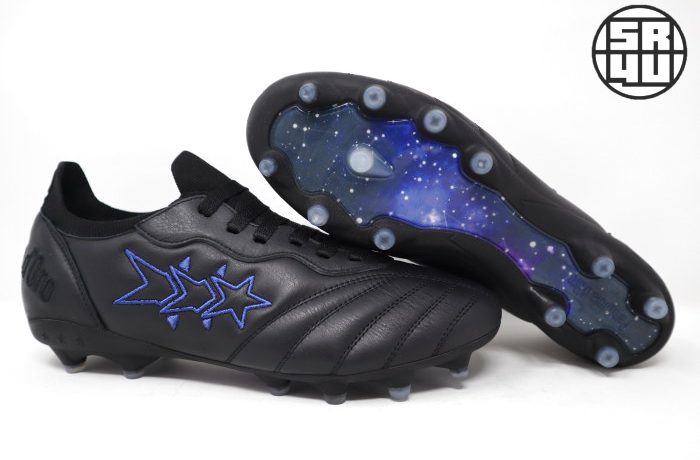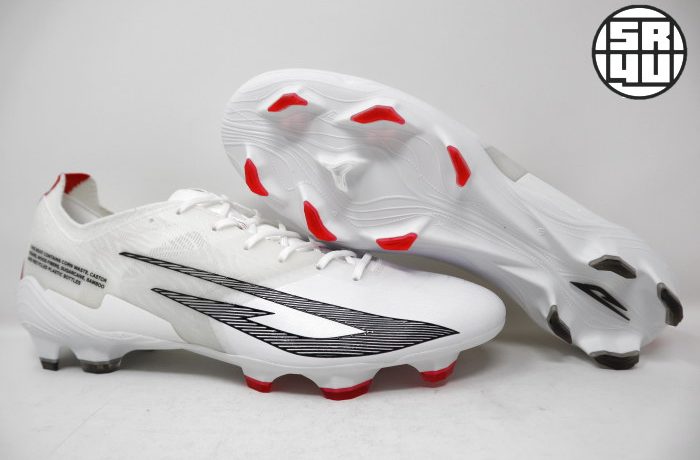The Superfly is back, but in a much different form factor than you may remember it. Nike’s Superfly series, first introduced in 2009, has always been about the latest and greatest, both in terms of design and technology. In 2011, the Superfly line ended at 3, leaving us waiting until mid-2014 for the Superfly 4, a boot that features an incredibly unique and intriguing design.
Maintaining the Superfly’s signature carbon fiber soleplate and a FlyWire-esque support system, now called Brio Cables, pretty much everything else about the Superfly 4 is new and never been done before. With the main talking points being the FlyKnit upper and Dynamic Fit Collar, the Superfly 4 is unlike any of its predecessors, and is truly the next step in Nike ever-evolving Mercurial line.
Comfort/Fit
The Superfly 4 fits and feels unlike anything else on the market, although the Nike Magista Obra will provide a somewhat similar type of feel. The upper is entirely made from FlyKnit, a material that Nike has been implementing in many of their performance models across several different sports over the last couple of years. FlyKnit is a machine knit material, made from various types of yarns and other synthetic fibers, creating a one-piece, seamless enclosure for your foot. What’s particularly attractive and exciting about the introduction of FlyKnit on a soccer cleat is that the construction process is 100% engineered, so Nike has control of every square millimeter of the upper. Nike can determine the thickness, strength and stretch of the entire upper, without seams, without extra material and without extra bulk, something that only makes this shoe great, but also leaves so much room for potential in future models. The possibilities are endless.
So, we know the concept is great, but how does it actually feel and perform? The answer to that question is complicated, but in a very positive way. First of all, the Superfly 4 is not for everybody. Some love the concept, and others hate it, and that’s fine. If you’re intrigued by the design and want to experience it for yourself, than the Superfly 4 is worth a shot. Nike has marketed the FlyKnit upper and mid-cut design as offering a sock-like fit, and that’s something that I can totally confirm as true. Upon putting the shoes on for the first time, the upper immediately wraps every inch of your foot, giving you that signature second-skin Mercurial fit, but with more softness and flexibility than you get from the usual Teijin synthetic uppers featured on all high-end Mercurials.
The FlyKnit upper is thin, and extremely flexible, allowing the upper to move very natural with the bend of your foot. Unlike the Magista Obra, the FlyKnit upper of the Superfly is a lot less structured, its pretty much one thickness across the entire upper. In order to achieve a properly responsive and secure feel, Nike has incorporated what they’re calling Brio Cables, similar to FlyWire, that run from the base of the sole, directly into the laces on both the medial and lateral sides of the upper. The Brio Cables, which are knitted directly into the upper, are very strong cables that provide tons of stability to the upper, not allowing it to roll over, no matter how hard you cut. When you pull the laces tight, you’ll immediately notice the supportive sensation of the Brio Cables, and what’s great is that it does not restrict the flexibility of the upper in any way at all, something that was a major issue with past Superfly models. So, if you were worried about the FlyKnit upper being too flimsy, don’t be, because the upper is shockingly responsive considering how thin and soft it is. Also keep in mind that the Superfly 4 features an internal support cage, fused directly to the upper, only adding to the stability of the entire upper.
Since the Superfly 4 is still part of the Mercurial line, it will of course be compared to current and older Mercurial models, but the experience is totally unique and simply does not compare. Back in 2012, FlyKnit was introduced as a material that would allow for both a sock-like fit and a sock-like level of comfort, while still allowing for proper support and structure by implementing different materials and patterns. Due to this story and the appearance of FlyKnit in general, many will look at the Superfly 4 and view it as a sock attached to some studs, and to certain extent, that’s exactly what it is.
You’ll find two varieties of FlyKnit on the upper, one section that is structured and another that is elasticated. The structured portion, spanning everywhere except the top of the foot, has very little to no stretch, and is also covered in a thin layer of NikeSkin for touch. The elasticated portion spans the top of the foot, under the laces, as well as the entire Dynamic Fit Collar. The stertchy areas of the shoe are key to the overall fit. When you slide the shoe on your foot, the stretch of those key areas will allow you to get the shoe on fairly easily, but once the shoe is one, it compresses to the exact shape of your foot. The boot is purposely cut a little tighter than the average shoe, and this is what allows for that tight fit, even without tying the laces. Once you tie the laces up, you get the extra stability of the Brio cables, reinforcing the sidewalls of the upper, as well as looking your foot down inside the boot.
The mid-cut design of the boot is an element of the Superfly 4 that many are skeptical about, mainly because it’s somewhat unusual. Admittedly, it is a little weird at first, not so much because of how it feels, but mostly because it’s something that you’re constantly thinking about, at least that was the case with me. The collar isn’t overly tight, but does have a snug fit, tight enough to wear you can feel that its there. With that said, it does not restrict movement whatsoever, and does not get in the way when making touches on the ball. After an hour or so, once I was concentrating more on playing rather than the new shoes on my feet, its something that I stopped noticing.
What’s great about the mid-cut design is that it provides that seamless sensation. As opposed to being shoes on your feet, the sock-like fit and mid-cut design makes the Superfly 4 feel like an extension of your body, part of you as opposed to a piece of equipment.
Inside the shoe, the heel is lined with a smooth synthetic material, similar to what you might find in other Mercurial models, backed by a decent amount of padding. The rear portion of the shoe also features an internal heel counter, providing the necessary structure and stability required of any soccer cleats. The insole is also fully removable, but definitely nothing special. It’s made from a single layer of perforated foam, with a mesh lining, providing some decent underfoot cushioning, and most importantly, it doesn’t slide around.
The new, and what I consider to be improved, carbon fiber soleplate is much more flexible than past variations, giving the boot a much more natural sensation when running. The latest iteration maintains the low-profile feel, but also a lot more flexibility through the mid-foot and toe area, making for a less extensive break-in process and a smoother running experience in general. In all honesty, it feels extremely similar to the new compressed nylon soleplate featured on the new Mercurial Vapor 10, which isn’t a bad thing at all. Its low-profile with no stud pressure and flexible, while still maintaining a slight responsive sensation, what more could you ask for? The looks aren’t so bad either.
As far as break-in is concerned, everyone is going to have a different experience. For me personally, I had no issues taking the Superfly 4 through an entire 2-hour training session with very minimal discomfort. With the being said, blisters can occur if you’re not careful. Minor heel slippage is not uncommon at first, and any kind of movement inside the boot can lead to discomfort and eventually a blister. The best way to avoid this is to make sure that you have the proper fit in the length of the shoe. This is not a shoe that you want to wear with tons of growing room. Due to the design of the upper, a snug fit is more or less required in order to achieve that one-to-one feel between your foot and the upper. Excessive space inside the boot is definitely something to avoid.
Another thing to consider when breaking in the Superfly 4 is to take things slowly. New shoes are exciting, I understand that, but if you’re wearing your new Superflys and start to feel discomfort anywhere on your feet, the heel seems to be the most common spot, take them off and switch into another pair for the rest of your session. Repeat this process until the shoes stop causing discomfort. This is a process that you should follow with any shoe, but since the Superfly features a more unusual fit, issues with discomfort at first are more likely to occur. Also, wearing new shoe straight into a game is never a good idea.
In terms of fit, the Superfly 4 maintains the same Mercurial shape that has been so popular for the longest time. This gives the boot a tighter fit overall, but the softness of the FlyKnit upper does make it feel slightly more generous width-wise in comparison to standard Teijin synthetic Mercurial models. With that said, this is still a boot with more of a narrow cut, so if you have wide feet, the Superfly 4 is probably not the best choice. If you fit into previous Mercurial models, or even in Nike’s Hypervenom line, you should fit comfortably in the Superfly 4. Also keep in mind that while the upper will give a little bit, it will not stretch, so the width of the boot from out of the box is a shape that the Superfly 4 will maintain throughout its entire lifespan.
As far as sizing goes, I found the Superfly 4 to run true to size. Just like wear in every other high-end Mercurial, wore a size 9US for review, and the fit in the length was pretty much perfect. Again, the FlyKnit upper is much more flexible than a standard Mercurial, so the fit in the toe box may be a little less snug than you may be accustomed too, giving many the impression that the Superfly 4 runs long, but that’s not actually the case. If you currently wear a pair of Mercurials with a snug fit to tight fit, the Superfly 4 will provide a very similar fit. I say similar because the Superfly 4 is not a standard Mercurial, so while they feel Mercurial-esque, there definitely is a unique aspect to how they fit. Overall, they run true to size, so if you’re planning on ordering, go for your normal size for the best possible fit.
Weight
In terms of weight, the SG-Pro Superfly 4, in a size 9US, weighs in at 7.7oz. In comparison to the FG version, which weighs in at 7oz in the same size, there definitely is some extra weight with the SG-Pro model, but not enough weight to make for a noticeable difference in feel when the shoes are on your feet. With that said, for an soft ground boot to be below the 8oz mark is still very light, so the extra weight of the SG-Pro variation shouldn’t be much of a concern. They’re going to a provide a nice lightweight feel, and that’s all that really matters.
Traction
The SG-Pro stud pattern for the latest Mercurial models, including the Superfly 4, has undergone some minor changes in comparison to previous models. The small changes honestly have no noticeable impact on the overall performance, and the stud pattern as a whole still performs great in soft, muddy conditions.
The SG-Pro stud pattern from Nike is something that has gained a lot of popularity ever since its release. It features a combination of six screw-in, metal studs and plastic molded studs, giving many the impression that SG-Pro is designed as a multi-surface stud pattern, and that’s just not the case. If you’re not going to be playing on soft ground, do not buy the SG-Pro stud pattern. With that being said, there are two sets of studs included with the purchase of a pair of SG-Pro shoes. Included is a set of 11mm and 13mm metal studs, as well as a set of 13mm and 15mm metal studs, allowing you to change your stud length depending on how soft the playing surface is.
The stud pattern itself performs great, but it is absolutely crucial that you’re using it on the correct playing surface. If you’re playing on firm, natural grass playing surfaces, than the standard firm ground stud pattern is what you want. Another misconception with the SG-Pro stud pattern is that you can use it on turf or artificial surfaces. I strongly suggest not doing so. As the name suggests, the stud pattern is for “soft ground”, which is more or less the exact opposite of a shallow artificial surface.
As far as the performance of the stud pattern is concerned, the plastic studs scattered around the metal ones do make for a different feel than you would normally get from your standard six stud, soft ground stud pattern. There are some additional grip points on the shoe, but what I am a big fan of is the extra stud right at the toe. This stud just gives that little bit of extra grip when pushing off, which could be the difference between slipping and staying on your feet in soft playing conditions. What’s unique to the Superfly SG-Pro, are the plastic studs being blades instead of conical studs. The extra plastic studs positioned in-between the six metal studs give the SG-Pro stud pattern a slightly different feel on the ball than your average six stud. I like the SG-Pro stud pattern because it provides the grip that you need when playing on soft ground, but offers the feel of a firm ground stud pattern on the ball. Soft ground stud patterns, in my opinion, all offer very similar amounts of traction, and that includes Nike’s SG-Pro stud pattern.
What’s more important when it comes to SG stud patterns is that you’re actually wearing them on soft ground, because if you’re not, the performance is not going to be that great. On soft ground, the SG-Pro stud pattern from Nike performs great, and is a nice improvement over the standard six-stud soft ground stud formation.
Touch
Unlike the Magista Obra, the FlyKnit upper of the Superfly 4 is made up of what appears to be a single layer, which makes for more of a barefoot feel for the ball. With that being said, Superfly 4 is more padded than a standard Mercurial, most notably the new Vapor 10. Along with being very soft and flexible, the FlyKnit upper is also provides a very slight amount of padding between your foot and the ball, which feels great. It’s a feel that I would compare to the NikeSkin upper of the Hypervenom Phantom, but thinner.
The upper is also finished off with a very thin layer of NikeSkin polyurethane, acting as both a protective layer for the upper and a grip element. If you’ve ever played around with a ball in your socks, than you know it makes for a very slick touch. In order to solve this problem, the NikeSkin layer across the majority of the upper provides a very subtle grip on the ball, without adding any bulk.
Just like all of Nike’s other top-end models, ACC (All Conditions Control) is also included as part of the package. ACC is a secretive process that Nike has, which improves the performance of the boot in wet weather, mainly by providing slightly more grip on the ball. Its tough to determine whether or not its an actual feature or simply the placebo effect in action, since you can’t actually see ACC, but I personally can notice a difference between an ACC and non-ACC boot. With all of that being said, it’s a nice feature that I’m glad Nike includes, but it isn’t something that is going to make or break your overall experience with the Superfly 4.
The mid-cut design is also a talking point when it comes to touch. Normally, soccer cleats are cut below the ankle, so to have a shoe cut above the ankle, you expect that extra material to get in the way. Fortunately, the mid-cut design has been very well thought out. The FlyKnit material is perfect for this type of design for the simple fact that it is thin, yet durable, and moves very naturally with your ankle. At no point did I feel like the collar was getting in the way, and in all honesty, you don’t even notice that its there when playing.
The best part about the Superfly when it comes to touch, is the seamless construction and fit of the boot. The upper wraps your foot perfectly, and since there are no overlapping materials or extra bulk in general, the boot feels more like a second-skin than just a pair of shoes. It’s a really unique and positive experience that makes the Superfly 4 so much fun to wear. If you’re looking for a barefoot feel with some very minor cushion, and a completely seamless feel, than you’ll love the new Superfly.
Shooting
Shooting the ball in the Superfly 4 is a very positive experience. The upper is thin, so naturally you get more of a responsive, pingy sensation when striking the ball. The seamless upper again offers a nice consistent feel no matter what part of the foot you’re using to hit the ball, providing what I would describe as a modified barefoot striking experience. There’s a slight grip sensation from the NikeSkin covering, but other than that, the sensation that you get is just very natural.
One could also argue that the mid-cut design helps with providing some extra support for the ankle when striking the ball, but for the most part, I would say that this is more the placebo effect as opposed to actual support.
Overall, if you’ve worn Mercurials in the past, you’ll feel right at home striking the ball in the Sueprfly 4.
Protection
Protection was a huge talking point when the FlyKnit was first unveiled, and I’m not so sure why. I can understand the reasoning of many people in that Nike marketed the FlyKnit upper of the Obra as “sock-like”, and while that is true to a certain extent, the upper of the Obra is far from a standard pair of socks in both quality and protection.
Unlike the Obra, where the GlyKnit upper is much more structured, and made up of several layers, the Superfly 4 is much thinner, which in turn makes for less protection. Again, if you’ve worn Mercurials in the past, the Superfly 4 is going to be on par with the amount of protection that they provide. If you want that barefoot sensation when making touches on the ball, you have to sacrifice protection.
It must also be said that the mid-cut design provides extra protection that you wouldn’t normally have around the ankle area. It, just like the rest of the upper, is several layers thick, and while it won’t cushion an impact to the ankle, it will certainly prevent a cut, and provide more protection than other shoe in this particular area.
Overall, there isn’t much protection here at all, but that’s not something that should be too surprising. The upper is thin and soft, meaning that the majority of your foot will be left “exposed” shot you take a blow to the foot. If protection is something that you value from your shoes, because at the end of the day protection is still a preference, than the Superfly 4 may not be the best choice. If you can live with the lack of protection for the sake of feel, than you shouldn’t have any issues with these.
Durability
The woven concept scares a lot of people, for the simple fact that people are worried that the upper will essentially unravel or snag, causing major damage to the boot. This is again a misconception with the Superfly, either because people aren’t familiar with FlyKnit or just because most have not yet held the Superfly in their hands. Once more people get to try out the Superfly for themselves, even just seeing them in person will change a lot of opinions when it comes to the structural integrity of the boot.
The FlyKnit upper does not snag, and will not unravel, its very well made. The majority of the upper is also covered in NikeSkin, which not only acts as a protective barrier for the FlyKnit upper, but also makes cleaning the boot much easier than you might expect. Even the areas of the upper that aren’t covered in NikeSkin have held up very well.
I’ve put a lot of hours on the pair that I used for testing, a lot more than I normally would, just to see if something would go wrong, and I’m happy to report that I haven’t had any concerns in regards to the longevity of the boot. Everything is still 100% intact, and feels as it did from day one. It’s a very well made product, and also one that seems to be pretty durable despite its unique design.
The Superfly 4 is a shoe that I can confidently say is built to last. This is a boot that should pretty easily get you through at least a season’s worth of play, if not longer should you take good care of them.
Please keep in mind that the SG-Pro Superfly 4, or any soft ground boot for that matter, is designed for use on soft natural grass playing surfaces, and nothing else. This is not the stud pattern to buy if you frequently play on firm to hard ground, and especially artificial grass/turf. Using SG boots on anything but soft ground will not only lead to poor performance, instability and stud pressure, but you can also damage the boot very quickly, rendering them useless. Just make sure that you’re using you’re SG boots on soft ground, and none of this will be an issue for you.
The Verdict
Nike never ceases to amaze when it comes to new and innovative products, especially as of late, and the Superfly 4 is part of their impressive line-up. Not only does it visually make a statement, demanding attention with its bright color and unusual mid-cut design, but it also performs the part!
The FlyKnit aspect of this boot is very impressive, and really shows the versatility of this new technology. They can make a more rugged, structured upper which they showed with the Obra, and can also make a more delicate, yet incredibly solid upper in the form of the Superfly 4. The upper is thin, soft and flexible but somehow maintains an incredible amount of support and responsiveness.
The sock-like fit, seamless design, carbon fiber soleplate and Mercurial stud pattern combine to make one of the most unique experiences I’ve ever had with a pair of shoes. As technologically advanced as the Superfly 4 may be, when you’re actually wearing the shoes, they just feel so simple. Everything feels right.
As positive an experience as I had with the boots, it still isn’t a shoe that I would recommend to everyone. The FlyKnit upper and mid-cut design will surely maintain its skeptics, and it’s really up to you to decide whether or not the Superfly 4 is the next boot for you. Some will love it, some will hate, but those who love it will really love it.
| Comfort/Fit | 10 out of 10 |
| Weight | 8 out of 10 |
| Traction | 10 out of 10 |
| Touch | 10 out of 10 |
| Shooting | 9 out of 10 |
| Protection | 6 out of 10 |
| Durability | 8 out of 10 |
| FINAL SCORE | 61 out of 70 or 87% |


